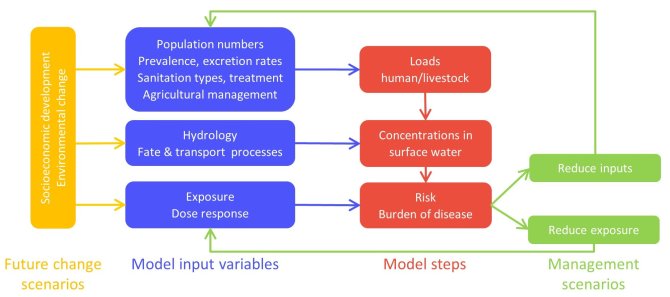
Project
WaterPath: a Future Scenario Toolkit for Waterborne Infectious Disease Modelling
Infectious waterborne diseases are globally still a major threat to human health. Climate change and other socio-economic changes may exacerbate this threat. In the WaterPath project we develop a toolkit with and for stakeholders to improve understanding in current and future health risks for the population and to help them design adaptation strategies.
Introduction
Infectious waterborne diseases are globally still a major threat to human health (Troeger et al., 2017). Due to the increasing pressure of climate change, progress achieved in global reductions of infectious water-related disease rates is threatened (Levy et al., 2018, Cissé., 2022). The concentration of waterborne pathogens and AMR bacteria and resulting disease in surface and drinking water varies under different socio-economic conditions, such as population and livestock densities, urbanisation, sanitation and treatment of wastewater and manure, and climate change, including extreme weather events, such as floods and droughts. To assess how socio-economic development and climate change can affect microbiological water quality and disease, researchers can apply scenario analysis using mathematical models (Hofstra, 2011, Hofstra et al 2019, Figure 1).

Objective
Tools that help stakeholders to inform their decisions on such adaptation strategies are not yet available. The aim of this project is to understand the impacts of socio-economic development and climate change on waterborne disease and spread of AMR to inform policy makers and help them design adaptation strategies.
(Expected) results
In this project we will develop a toolkit with stakeholders. This toolkit will provide knowledge for stakeholders on main patterns in pathogen concentrations and disease risk now and in the future (2030, 2050, 2100). Additionally, it will present the main sources of contamination and interventions. Moreover, for modellers, the toolkit will provide open access to the Global Waterborne Pathogen (GloWPa) model and the data required for the model (present and future scenarios). In the project we will develop the GloWPa model further to include extreme events and Quantitative Microbial Risk Assessment globally and for case-study regions. The developed model and toolkit will help stakeholders to identify and mitigate potential waterborne pathogen problems and associated health risks.